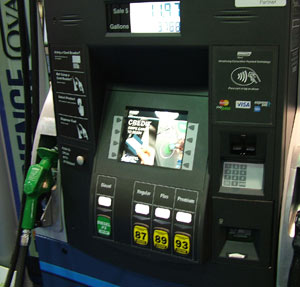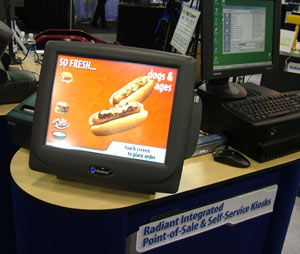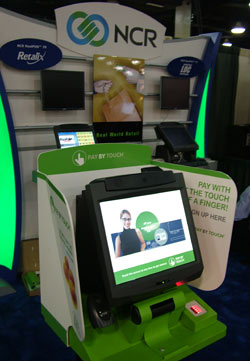Article
Standards take center stage at NACStech 2006
The annual technology summit of the National Association of Convenience Stores was host to the gamut of devices that power c-stores - and the standard that aims to help them all communicate.
May 31, 2006 by James Bickers — Editor, Networld Alliance
To the consumer, a convenience store is a wonderfully simple thing: a place to buy some gas and milk, maybe a lottery ticket, perhaps a car wash. It is so deeply rooted in our modern culture, it is usually taken for granted (until, of course, your next trip to a town without one).
But what goes on behind the scenes is anything but simple. The typical c-store is a bewildering daisy-chain of systems, technologies and processes, usually from different vendors and working in proprietary ways.
This year's NACStech event at the Gaylord Opryland Convention Center, March 22-24 in Nashville, Tenn., was host to most of those systems and technologies, from pay-at-the-pump terminals to foodservice ordering kiosks to POS systems. And this year more of them bore the logo that said they are approved for PCATS, the emerging technology standard that aims to make them all talk to one another.
PCATS, or the Petroleum Convenience Alliance for Technology Standards, is an offshoot of a project the National Association of Convenience Stores began in 2003.
"There are 19 reconciliation reports that a c-store manager has to prepare in an eight-hour shift," said Ed McGunn, president of show exhibitor Corporate Safe Specialists and a member of the PCATS board. "And that's usually an $8.50-an-hour employee who has to do it. It's no wonder there's such a high turnover in this industry."
And turnover isn't the only problem. A store full of proprietary technologies costs money to integrate, money to maintain, and represents a substantial amount of lost revenue and wasted time.
"In the past, all of the various devices that sit on a counter in a c-store didn't talk to one another," said John Hervey, executive director of PCATS. "Lottery terminals were standalone - if you sold a lottery ticket, you had to be sure the cashier then went over to the POS and entered the sale, because there was no link between the two. Same thing with money orders and all those other devices."
 |
| Dresser Wayne's iX Media series, which delivers rich media and coupons at the pump |
The PCATS solution to this is the Open Site Architecture, a series of rules that allows conforming machines to "plug-and-play" into the store's network operation. Hervey said the Architecture is about 75 percent complete, and will likely be finished by the end of this year.
When that happens, c-store owners will be able to shop for components and technologies with an eye on the "PCATS-compliant" logo, knowing that any such tools they buy will work together.
Hervey said the ability to still shop among competing vendors will be a big plus for c-stores.
"In this industry, people like to buy a POS from one vendor that they consider best, and an accounting system that might be different," he said. "In the past, to make those two speak to one another, the retailer had to pay to have an interface written. When one of them changed, the retailer had to pay someone to make the changes on both sides of the equation."
 |
| Radiant's integrated POS and self-ordering solution |
He added that operators will notice significant cost savings and revenue increases, both immediately and over time.
"Today, the lottery machine has a telephone line, the ATM has a telephone line, the kiosk for bill payment has a phone line, the tank gauge monitor has a phone line - when you put the architecture in place, you can share services and reduce a lot of expense," he said.
Another real-world example of ROI comes at the street - or more specifically, at the price sign. Assuming an average weekly change of $.05 in gas price, and assuming it takes 2 hours for a store manager to react to a price change and update the signage manually, a digital sign system that is integrated with the back-office (i.e. updated instantly to reflect higher prices) would net a small store an additional $62,000 in revenue a year.
On the show floor
 |
| Pay By Touch, NCR's biometric payment solution |
At the NCR booth, attendees got a closer look at the biometric payment options offered by Pay By Touch, as well as NCR's 7405 Service Center kiosk, which dispenses money orders and prepaid products.
Xpedient demonstrated its food-ordering software solution, which has been successfully implemented with the Thornton's SubWorks program.
Fiscal Systems showcased its rugged outdoor kiosk, used for truck fleet management programs. Kevin Struthers, Fiscal's vice president, said the device is in 70 travel centers, where truckers can purchase gasoline, get paycheck advances and even purchase showers. The trucking company can closely monitor and control where and when the drivers stop to refuel, in order to take advantage of lower taxes in different geographic regions.
Gilbarco brought its car wash kiosk, which acts as an extension of the in-store POS. Chris Whitley, Gilbarco's director of retail systems sales, said the integration with the existing card processing network saves money by eliminating the second network often needed at the car wash - and allows the retailer to take all major payment methods, including fleet cards.
Dresser Wayne brought a number of modern pay-at-the-pump units, including the iX Media series that displays rich media at the pump and prints coupons on receipts. The company also announced it had just received the "Partner of the Year" award from Microsoft's Windows Embedded Partner program.
 |
| Gilbarco's car wash kiosk, which acts as an extension of the POS inside the store |
VeriFone demonstrated its new Food Service Kiosk Solution, an extension of the VeriFone POS. The product is currently in beta testing.
Radiant Systems showcased a comprehensive suite of products that extends from POS to customer-facing terminals and digital signage. The company also turned heads at its booth with a virtual reality racecar game.
Hypercom's payment terminals included a number of contactless-compliant keypads. The Optimum L4100 model contains a 5.7-inch color screen, making it possible to bring rich media to the point of purchase.
Wincor Nixdorf was on hand with its comprehensive POS and customer-facing platform. The company recently made news when it became the first European firm to offer plug-and-play functionality for retail peripherals verified to run on Microsoft Windows Embedded for Point of Service.
Touch-n-Buy brought its semi-assisted prepaid product kiosk, a tabletop unit that lets customers customize a prepaid or stored-value product; the card is then printed at a small cashier-facing unit. According to Carlos Rodriquez, vice president, the Touch-n-Buy unit is deployed in over 5,000 c-stores.










